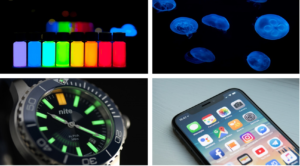
Menu
At Halloween time, we often see spooky costumes and decorations with elements that glow in the dark. But how does it happen? Has a sorcerer conjured a spell? Did a witch brew a potion? Or, could it be…science?
Costumes glow in the dark due to phosphorescence.
Phosphorescence is a type of photoluminescence – a light emission from another form of matter after a photon is absorbed. In this edition of Science Explained, we will explore the scientific phenomenon responsible for this spooky glow.

When light is shone on a molecule, the atoms inside the molecule get excited at this increase in energy (think about how you feel after too many sweets from trick or treating!). But the molecule can’t hold this energy level for long, it must go somewhere. When photoluminescence occurs, the energy is released as light.
This happens in both fluorescence and phosphorescence, but phosphorescence occurs when the molecule contains a “phosphor”. This takes a bit longer to release the light, ranging from microseconds to hours.
Because phosphorescence can last for hours, it’s ideal for using in Halloween costumes and decorations to add some magic!
Of course, phosphorescence isn’t just for Halloween costumes and decorations. It actually used for safety signs and lighting, making paths and signs visible in low light situations without electricity.
In theory, as long as glow in the dark objects are exposed to light, they can “recharge” continuously until the phosphor degrades over time.

How many types of Halloween costumes have you seen this year that glow in the dark? Let us know your favourite on social media!

